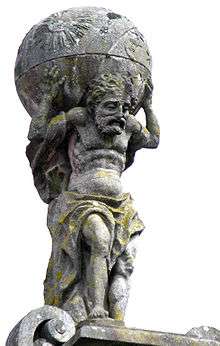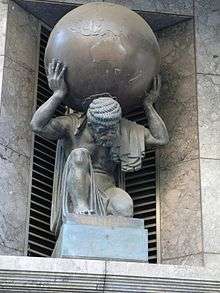Atlas (mythology)
| Atlas | |
|---|---|
|
| |
| Abode | Western edge of Gaia (the Earth) |
| Personal Information | |
| Consort | Pleione, Hesperius |
| Children | The Hesperides, the Hyades, Hyas, the Pleiades, Calypso, Dione and Maera |
| Parents | Iapetus and Asia or Clymene |
| Roman equivalent | Atlas |
In Greek mythology, Atlas (/ˈætləs/; Ancient Greek: Ἄτλας) was a Titan condemned to hold up the sky for eternity after the Titanomachy. Although associated with various places, he became commonly identified with the Atlas Mountains in northwest Africa (modern-day Morocco, Algeria and Tunisia).[1] Atlas was the son of the Titan Iapetus and the Oceanid Asia[2] or Clymene.[3] He had many children, mostly daughters, the Hesperides, the Hyades, the Pleiades, and the nymph Calypso who lived on the island Ogygia.[4] According to the ancient Greek poet Hesiod Atlas stood at the ends of the earth towards the west.[5]
According to Robert Graves's The Greek Myths, the Pelasgians believed the creator goddess Eurynome assigned Atlas and Phoebe to govern the moon.[6]
Hyginus emphasises the primordial nature of Atlas by making him the son of Aether and Gaia.[7]
"Atlantic Ocean" means "Sea of Atlas", while "Atlantis" means "island of Atlas".

Etymology

The etymology of the name Atlas is uncertain. Virgil took pleasure in translating etymologies of Greek names by combining them with adjectives that explained them: for Atlas his adjective is durus, "hard, enduring",[8] which suggested to George Doig[9] that Virgil was aware of the Greek τλῆναι "to endure"; Doig offers the further possibility that Virgil was aware of Strabo's remark that the native North African name for this mountain was Douris. Since the Atlas mountains rise in the region inhabited by Berbers, it has been suggested that the name might be taken from one of the Berber, specifically ádrār 'mountain'.[10]
Traditionally historical linguists etymologize the Ancient Greek word Ἄτλας (genitive: Ἄτλαντος) as comprised from copulative α- and the Proto-Indo-European root *telh₂- 'to uphold, support' (whence also τλῆναι), and which was later reshaped to an nt-stem.[11] However, Robert Beekes argues that it cannot be expected that this ancient Titan carries an Indo-European name, and that the word is of Pre-Greek origin, and such words often end in -ant.[11]
Children
Sources describe Ahters. Some of these are assigned conflicting or overlapping identities or parentage in different sources.
Mythology
Punishment
Atlas and his brother Menoetius sided with the Titans in their war against the Olympians, the Titanomachy. When the Titans were defeated, many of them (including Menoetius) were confined to Tartarus, but Zeus condemned Atlas to stand at the western edge of Gaia (the Earth) and hold up the sky on his shoulders, to prevent the two from resuming their primordial embrace. Thus, he was Atlas Telamon, "enduring Atlas," and became a doublet of Coeus, the embodiment of the celestial axis around which the heavens revolve.[19]
A common misconception today is that Atlas was forced to hold the Earth on his shoulders, but Classical art shows Atlas holding the celestial spheres, not a globe; the solidity of the marble globe borne by the renowned Farnese Atlas may have aided the conflation, reinforced in the 16th century by the developing usage of atlas to describe a corpus of terrestrial maps.
Variations
In a late story,[20] a giant named Atlas tried to drive a wandering Perseus from the place where the Atlas mountains now stand. In Ovid's telling,[21] Perseus revealed Medusa's head, turning Atlas to stone (those very mountains) when Atlas tried to drive him away, because Perseus, who went there accidentally and asked Atlas for hospitality, named himself a son of Zeus and a prophecy said that a son of Zeus would steal the golden apples from Atlas' orchard. As is not uncommon in myth, this account cannot be reconciled with the far more common stories of Atlas' dealings with Heracles, another son of Zeus, who was Perseus' great-grandson and who sought for the golden apples.
According to Plato, the first king of Atlantis was also named Atlas, but that Atlas was a son of Poseidon and the mortal woman Cleito.[22] A euhemerist origin for Atlas was as a legendary Atlas, king of Mauretania, an expert astronomer.
Encounter with Heracles
One of the Twelve Labors of the hero Heracles was to fetch some of the golden apples which grow in Hera's garden, tended by Atlas' daughters, the Hesperides, and guarded by the dragon Ladon. Heracles went to Atlas and offered to hold up the heavens while Atlas got the apples from his daughters.
Upon his return with the apples, however, Atlas attempted to trick Heracles into carrying the sky permanently by offering to deliver the apples himself, as anyone who purposely took the burden must carry it forever, or until someone else took it away. Heracles, suspecting Atlas did not intend to return, pretended to agree to Atlas' offer, asking only that Atlas take the sky again for a few minutes so Heracles could rearrange his cloak as padding on his shoulders. When Atlas set down the apples and took the heavens upon his shoulders again, Heracles took the apples and ran away.
In some versions,[23] Heracles instead built the two great Pillars of Hercules to hold the sky away from the earth, liberating Atlas much as he liberated Prometheus.
Etruscan Aril
The identifying name Aril is inscribed on two 5th-century Etruscan bronze items, a mirror from Vulci and a ring from an unknown site.[24] Both objects depict the encounter with Atlas of Hercle, the Etruscan Heracles, identified by the inscription; they represent rare instances where a figure from Greek mythology is imported into Etruscan mythology, but the name is not. The Etruscan name aril is etymologically independent.
Cultural influence


Atlas' best-known cultural association is in cartography. The first publisher to associate the Titan Atlas with a group of maps was the print-seller Antonio Lafreri, on the engraved title-page he applied to his ad hoc assemblages of maps, Tavole Moderne Di Geografia De La Maggior Parte Del Mondo Di Diversi Autori (1572);[26] however, he did not use the word "atlas" in the title of his work, an innovation of Gerardus Mercator, who dedicated his "atlas" specifically "to honour the Titan, Atlas, King of Mauretania, a learned philosopher, mathematician, and astronomer"; he actually depicted the astronomer king.
See also
- Atlas (architecture)
- Bahamut, a rough analogue from Arabian mythology, and other members of Category:World-bearing animals
- Farnese Atlas
- Upelluri
- Atlas of Mauretania
Notes
- ↑ Smith. "Atlas". Retrieved February 26, 2013.
- ↑ Pseudo-Apollodorus, Bibliotheke i.2.3.
- ↑ Hesiod (Theogony 359 [as a daughter of Tethys], 507) gives her name as Clymene but the Bibliotheca (1.8) gives instead the name Asia, as does Lycophron (1411). It is possible that the name Asia became preferred over Hesiod's Clymene to avoid confusion with what must be a different Oceanid named Clymene, who was mother of Phaethon by Helios in some accounts.
- ↑ Homer, Odyssey, 1.14, 1.50. Calypso is sometimes referred to as Atlantis (Ατλαντίς), which means the daughter of Atlas, see the entry Ατλαντίς in Liddell & Scott, and also Hesiod, Theogony, 938.
- ↑ Hesiod, Theogony 515
- ↑ Graves, Robert (1992). The Greek Myths. Penguin Books. p. 27. ISBN 0140171991.
- ↑ Hyginus, Preface to Fabulae.
- ↑ Aeneid iv.247: "Atlantis duri" and other instances; see Robert W. Cruttwell, "Virgil, Aeneid, iv. 247: 'Atlantis Duri'" The Classical Review 59.1 (May 1945), p. 11.
- ↑ George Doig, "Vergil's Art and the Greek Language" The Classical Journal 64.1 (October 1968, pp. 1-6) p. 2.
- ↑ Strabo, 17.3;
- 1 2 Beekes, Robert; van Beek, Lucien (2010). "Etymological Dictionary of Greek". 1. Brill: 163{{inconsistent citations}}
- ↑ Diodorus Siculus, The Library of History 4.26.2
- ↑ Hyginus, Astronomica 2.21; Ovid, Fasti 5.164
- 1 2 Hyginus, Fabulae 192
- ↑ Hesiod, Works and Days 383; Bibliotheca 3.110; Ovid, Fasti 5.79
- ↑ Homer, Odyssey 1.52; Apollodorus, E7.23
- ↑ Hyginus, Fabulae 82, 83
- ↑ Pausanias, Guide to Greece 8.12.7, 8.48.6
- ↑ The usage in Virgil's maximum Atlas axem umero torquet stellis ardentibus aptum (Aeneid, iv.481f , cf vi.796f), combining poetic and parascientific images, is discussed in P. R. Hardie, "Atlas and Axis" The Classical Quarterly N.S. 33.1 (1983:220-228).
- ↑ Polyeidos, Fragment 837; Ovid, 'Metamorphoses 4.627
- ↑ Ovid, Metamorphoses, IV.617ff (on-line English translation at TheoiProject).
- ↑ Plato, Critias
- ↑ A lost passage of Pindar quoted by Strabo (3.5.5) was the earliest reference in this context: "the pillars which Pindar calls the 'gates of Gades' when he asserts that they are the farthermost limits reached by Heracles"; the passage in Pindar has not been traced.
- ↑ Paolo Martini, Il nome etrusco di Atlante, (Rome:Università di Roma) 1987 investigates the etymology of aril, rejecting a link to the verbal morpheme ar- ("support") in favor of a Phoenician etymon in an unattested possible form *'arrab(a), signifying "guarantor in a commercial transaction" with the connotation of "mediator", related to the Latin borrowing arillator, "middleman". This section and note depend on Rex Wallace's review of Martini in Language 65.1 (March 1989:187-188).
- ↑ "Nautilus Cup". The Walters Art Museum.
- ↑ Ashley Baynton-Williams. "The 'Lafreri school' of Italian mapmakers". Retrieved February 26, 2013.
References
- Origin of the term "Atlas" as a name for a collection of maps
- Robert Graves, The Greek Myths, London: Penguin, 1955; Baltimore: Penguin. ISBN 0-14-001026-2
- Smith, William; Dictionary of Greek and Roman Biography and Mythology, London (1873). "Atlas"
External links
| Wikimedia Commons has media related to: |
- Warburg Institute Iconographic Database (ca 140 images of Atlas)